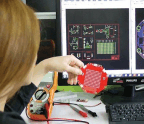
Many sheds are not lined, and for most this is not an issue. Given that my neighbours are reasonably close, and I live in a place with noticeably very hot summers, I looked at lining and insulating my shed as part of the project. I also knew that if I didn’t insulate the shed during construction, I would find it difficult to ‘get around to it’ once machines, power, etc. had been installed.
The first thing to do was insulate the north wall with the same type of insulation as used on the roof. Care was taken to keep the insulation out of the cable ladder – now within the wall profile – so it did not create a significant derating issue for the cables once installed.
What do you line a shed with?
I had several options to consider, including plasterboard, plywood, and particle board. Each had its pros and cons, so I looked at other builds and asked on a few forums for advice. Cost did play a factor in the final decision.
Criteria in the decision
1. Something I could work with for the construction – not needing specialised tools or skills that I didn’t already have or could not get quickly
2. The ability to hang things off the walls once lined – shelves, electrical fittings, etc.
3. A moderate impact resistance – no one wants damage to walls, but a lengthy repair afterwards is insult to injury
4. Able to be painted easily to make the walls lighter, cover stains, and so on
5. Construction with one or two people – and minor scaffolding, if at all
6. Cost and availability
7. Sound deadening – nice to have
Options considered
Plasterboard (Gyprock) with stud walls: Easy to build, moderate cost, strong walls – provided you hang things off the studs. Synopsis: Met criteria 1, 4, 5, and 6 easily, and 2 and 3 with some restrictions.

Plywood: Based on thickness and grade, the walls met all criteria except 6.
Plywood with thicknesses below 15mm were cheaper, but needed a stud wall for strength, which took the cost higher than plasterboard; 15, 18, and 21mm plywood was prohibitively expensive. Synopsis: Met 1, 2, 3, 4, 5 and 7; cost was high.
Particle board: Most grades of particle board were similar to plywood for cost and constraints. However, the particle board used for flooring showed a lot of promise. It handled the spans I was using without a stud wall and allowed me to affix things to the wall anywhere. One side that took paint well – the other being wax treated for water resilience – and I received some very competitive pricing options for this product. Synopsis: Met 1, 2, 3, 4, 5, 6, and 7.






